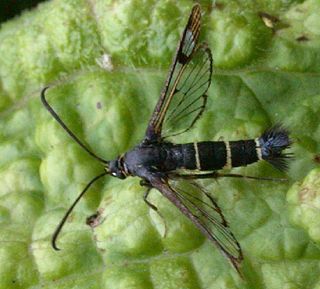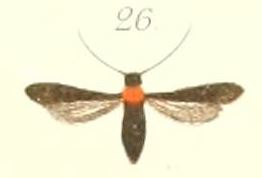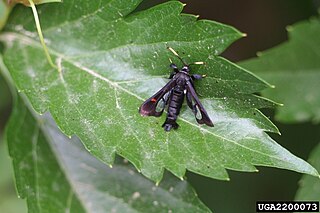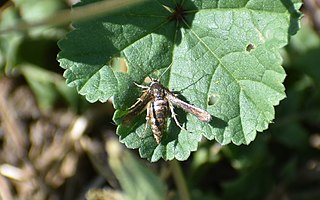
The Sesiidae or clearwing moths are a diurnal moth family in the order Lepidoptera known for their Batesian mimicry in both appearance and behaviour of various Hymenoptera.

The hornet moth or hornet clearwing is a large moth native to Europe and the Middle East and has been introduced to North America. Its protective coloration is an example of Batesian mimicry, as its similarity to a hornet makes it unappealing to predators. The hornet moth has been linked to the large dieback of poplar trees across Europe because its larvae bore into the trunk of the tree before re-emerging as adults.

Synanthedon culiciformis, known as the large red-belted clearwing, is a moth of the family Sesiidae. It is found in the Palearctic and Nearctic realms.
Tinthia xanthospila is a moth of the family Sesiidae. It is only known from the type specimen, which was collected at Cedar Bay in Queensland, Australia.
Nokona carulifera is a moth of the family Sesiidae. It is only known from Kuranda in Queensland, but probably occurs throughout the western coastal regions of Queensland.
Pseudosesia zoniota is a moth of the family Sesiidae. It is known only from the female holotype which was collected near the Claudie River on the Cape York Peninsula in Queensland, Australia.
Melittia doddi is a moth of the family Sesiidae. It is known only from Queensland, where it was collected near Kuranda.
Ichneumenoptera xanthogyna is a moth of the family Sesiidae. It is known only from locations near Kuranda in Queensland, Australia.

Bembecia ichneumoniformis, the six-belted clearwing, is a moth of the family Sesiidae.

Tinthia is a genus of moths in the family Sesiidae.

Synanthedon andrenaeformis, the orange-tailed clearwing, is a moth of the family Sesiidae. It is known from most of Europe. It is also present in the Near East.

Albuna fraxini, the Virginia creeper clearwing, is a moth of the family Sesiidae. It is known from the northern United States and southern Canada.

Chamaesphecia crassicornis is a moth of the family Sesiidae. It is found in south-eastern Austria, southern Slovakia, Hungary, Serbia, Romania, Bulgaria, southern Russia, Kazakhstan and Kyrgyzstan. It is rare in central Europe. It has been released in North America for the biological control of leafy spurge.
Negotinthia myrmosaeformis is a moth of the family Sesiidae. It is found in the countries around the Black Sea, including Ukraine, southern Russia, Romania, Bulgaria and the southern part of the Balkan Peninsula. It has also been recorded from Asia Minor, northern Iraq, Armenia and Azerbaijan.

Synanthedon scoliaeformis, the Welsh clearwing, is a moth of the family Sesiidae. It is found from almost all of Europe, east through Russia to Japan.

Microsphecia tineiformis is a moth of the family Sesiidae. It is found in southern Europe. It has also been recorded from Morocco, Algeria, Tunisia, Asia Minor, Armenia and from Azerbaijan to northern Iran and northern Iraq.

The Tinthiinae are a subfamily of clearwing moths, first established in 1917 by Ferdinand Le Cerf.








